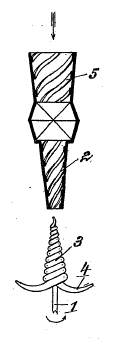
The object of the invention is a hydro-electric device, which exploits the kinetic energy of a water jet for the purposes of generating electricity.
The invention is characterised by a cone-shaped rotor, whose apex points towards the outlet opening, and rotates about an axis common to both rotor and water jet. The outer face of the cone is formed of upward-facing, concave, corkscrew-like blades. In this way the water-jet is split up and deflected from its path and imparts its full force to the rotor, so that, with the appropriate proportions between the height of the cone and the width of its base, and a suitable pitch of the blades, the size of which is dependent on the velocity of the impacting water-jet, the water flows from the machine quietly without creating spray.
An example of the arrangement of the invention is schematically depicted in the diagram.
The rotor, whose axle 1 is parallel and common to the axis of the jet exiting from the jet-pipe 2, is formed of corkscrew-like blades 3. The ends 4 of the blades 3 are curved upwards slightly towards the impacting water-jet so as to deflect the jet and to effect the greatest possible transfer of its kinetic energy to the rotor. In the jet-pipe 2 screw-like ribs 5 are incorporated, which, according to observations, increase the velocity of the exiting water-jet and the efficiency of the device.
Claims:
1. The jet-turbine is characterised by a cone-shaped rotor positioned in the axis of the water-jet, by means of which the water-jet is split up. Corkscrew-like blades
(5) are incorporated around the cone’s periphery (7).
2. In accordance with Claim 1, the jetturbine is further characterised by a jetpipe (2) incorporating rifling ribs (5), which impart a spin to the rotor in the direction of its rotation.